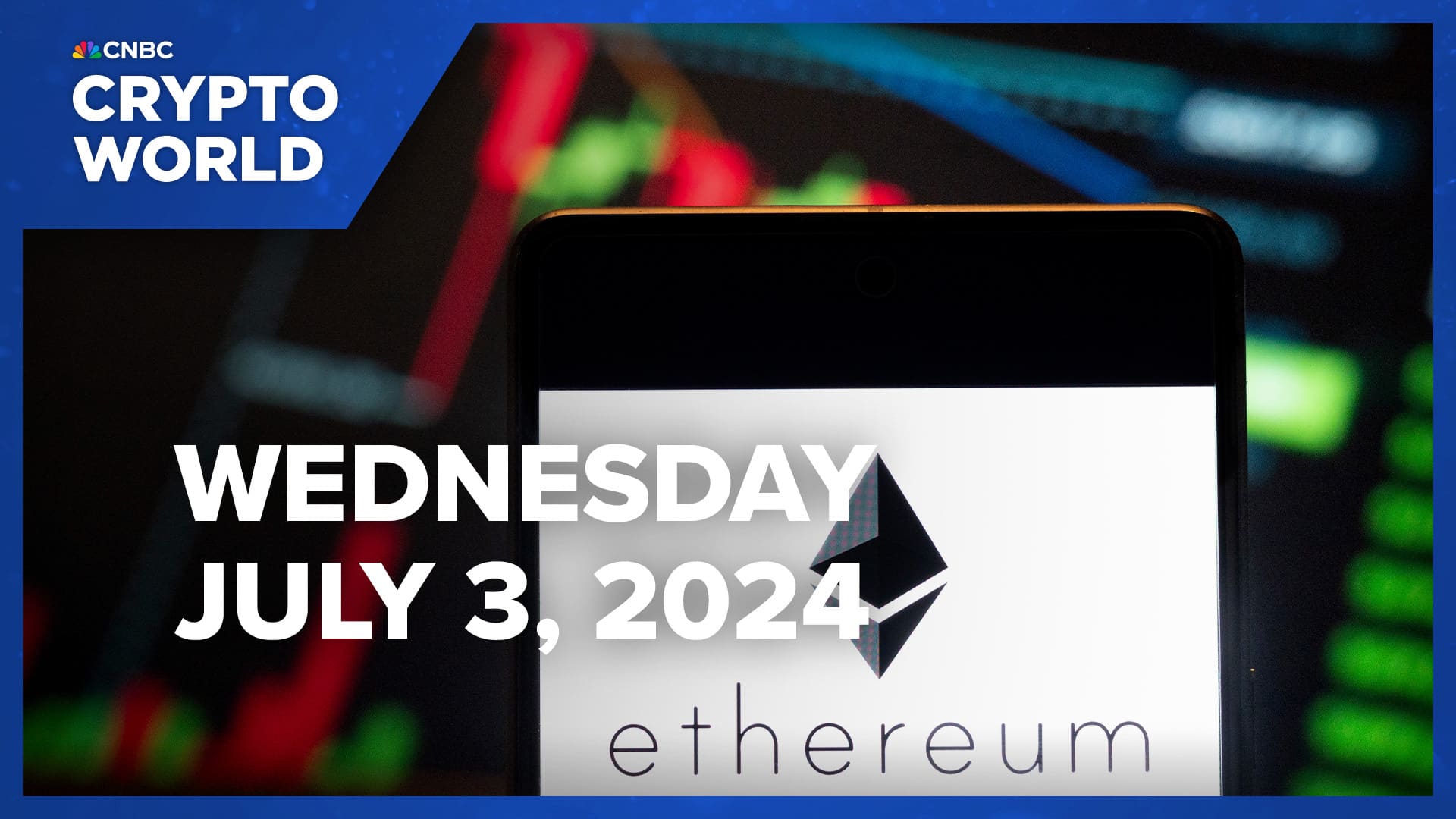News
Cryptocurrency “re-staking” platforms grow as traders chase higher returns

By Elizabeth Howcroft
LONDON (Reuters) – More than $18 billion worth of cryptocurrencies have been moved to a new type of platform that offers investors rewards in exchange for locking up their tokens, in a complex scheme that analysts say poses a risk to users and for the cryptocurrency market.
The growing popularity of so-called “re-staking” is the latest sign of risk-taking in cryptocurrency markets as prices rise and traders chase yield. Bitcoin, the largest cryptocurrency, is near all-time highs while Ether, the second largest, is up more than 60% this year.
At the center of the re-staking boom is Seattle-based start-up EigenLayer. The company, which raised $100 million from the crypto arm of US venture capital firm Andreessen Horowitz in February, has attracted $18.8 billion in cryptocurrencies to its platform, up from less than $400 million six months ago .
EigenLayer invented re-staking to expand a long-standing cryptographic practice called staking, its founder Sreeram Kannan told Reuters.
Blockchains are a kind of database, involving many computers in a network that monitor and confirm who owns which cryptocurrencies. To do this, owners of crypto tokens, such as Ether, allow their assets to be locked as part of the validation process. Holders lose immediate access to their tokens as long as they participate in staking, but in exchange they earn a return.
Some staking platforms also offer users newly created cryptocurrencies to represent the cryptocurrencies they have staked. Re-staking allows owners to take those new tokens and re-stake them with different blockchain-based programs and applications in hopes of higher returns.
The cryptocurrency world is divided over how risky re-staking is, with some industry insiders saying the practice is too nascent to know.
But others, including analysts, worry that if new tokens representing re-staking cryptocurrencies are used as collateral in the vast crypto lending markets, there could be endless cycles of lending based on a small number of underlying assets. That could destabilize broader cryptocurrency markets if everyone tries to exit at the same time, they say.
“When you have something that has collateral upon collateral, it’s not ideal, it adds a new element of risk that wasn’t there,” said Adam Morgan McCarthy, research analyst at crypto data provider Kaiko.
The attraction for investors is the yield: returns from staking on the Ethereum blockchain are typically between 3% and 5%, but analysts say returns could be higher for re-staking, as the investors can earn multiple returns at once.
Re-staking is the latest development in the risky world of decentralized finance, or DeFi, in which cryptocurrency holders invest in experimental schemes in the hope of generating large returns on their holdings without having to sell them.
The story continues
However, the EigenLayer platform has yet to pay out staking rewards directly to users, because the mechanism to do so has not been developed. Users join the platform in anticipation of future rewards or other freebies known as airdrops.
For now, EigenLayer has distributed its newly created token to people using the platform. Users hope that this token called “EIGEN” will be worth something in the future.
Kaiko’s Morgan McCarthy said the growth of re-staking platforms has been fueled by users seeking such launches, calling it “really, really speculative, this free money thing.”
“It’s very risky,” said David Duong, head of research at U.S. cryptocurrency exchange Coinbase, which offers staking but not re-staking.
“They’re doing it preemptively right now, (with the) expectation of being rewarded with something but they don’t know what,” Duong said.
ENTER EIGENLAYER
EigenLayer was launched last year by Sreeram Kannan, a former assistant professor at the University of Washington in Seattle and part of a team that launched the first student-designed micro-satellite in India, according to his academic website.
EigenLayer describes itself as a marketplace for validation services, connecting would-be stakers with applications that need staking tokens.
New re-staking platforms have emerged, including EtherFi, Renzo and Kelp DAO, which re-stake customer tokens on EigenLayer for them and generate new tokens to represent those re-staking assets. These tokens can be used elsewhere, for example as collateral in loans.
Kannan said the goal of his platform is to allow users to choose where to stake their tokens and help the growth of new blockchain services, not to increasingly incentivize cryptocurrency-backed loans.
“We have no official relationship with any of these players… This is an emerging phenomenon,” he said.
Coinbase’s Duong says re-staking could pose “hidden risks”: If re-staking tokens were used in crypto lending, there could be forced liquidations and increased volatility during market downturns, he wrote in a note.
The 2022 sell-off in cryptocurrency markets was exacerbated by high-risk lending, as crypto tokens used as collateral rapidly lost their value following the collapse of the Earth and Moon tokens.
Kannan distances EigenLayer from risks.
“The risk is not in the re-staking but rather in the lending protocols. The lending protocols are incorrectly pricing the risk,” he said.
Some experts are not concerned about re-staking, pointing out that the money made from re-staking protocols is tiny compared to the $2.5 trillion in net assets of the global cryptocurrency industry.
Regulators have long been concerned about losses in the cryptocurrency world spilling over into broader financial markets.
“For now, we see no significant risk of contagion from repositioning of issues in traditional financial markets,” said Andrew O’Neill, head of digital asset analysis at S&P Global Ratings.
However, the world of cryptocurrencies is becoming more and more connected to traditional finance and re-staking is gaining traction among institutional investors.
Zodia Custody, a division of Standard Chartered, has seen significant institutional interest in staking, but believes re-staking is a step too far because it is difficult to establish a “paper trail” of where assets go and how rewards are split, Chief Risk Officer Anoosh Arevshatian said.
Nomura’s crypto arm, Laser Digital, has partnered with Kelp DAO to reshare some of its funds, Kelp DAO said in an April blog post. Laser Digital did not respond to a Reuters request for comment.
Cryptocurrency-focused Swiss bank Sygnum said it stakes customers’ crypto assets and expects “a new ecosystem to emerge around re-staking.”
(Reporting by Elizabeth Howcroft; Editing by Tommy Reggiori Wilkes and Sharon Singleton)
News
How Ether Spot ETF Approval Could Impact Crypto Prices: CNBC Crypto World

ShareShare article via FacebookShare article via TwitterShare article via LinkedInShare article via email
CNBC Crypto World features the latest news and daily trading updates from the digital currency markets and gives viewers a glimpse of what’s to come with high-profile interviews, explainers and unique stories from the ever-changing cryptocurrency industry. On today’s show, Ledn Chief Investment Officer John Glover weighs in on what’s driving cryptocurrency prices right now and how the potential approval of spot ether ETFs could impact markets.
News
Miners’ ‘Capitulation’ Signals Bitcoin Price May Have Bottomed Out: CryptoQuant

According to CryptoQuant, blockchain data shows signs that the Bitcoin mining industry is “capitulating,” a likely precursor to Bitcoin hitting a local price bottom before reaching new highs.
CryptoQuant analyzed metrics for miners, who are responsible for securing the Bitcoin network in exchange for newly minted BTC. As outlined in the market intelligence platform’s Wednesday report, multiple signs of capitulation have emerged over the past month, during which Bitcoin’s price has fallen 13% from $68,791 to $59,603.
One such sign includes a significant drop in Bitcoin’s hash rate, the total computing power that backs Bitcoin. After hitting a record high of 623 exashashes per second (EH/s) on April 27, the hash rate has fallen 7.7% to 576 EH/s, its lowest level in four months.
“Historically, extreme hash rate drawdowns have been associated with price bottoms,” CryptoQuant wrote. In particular, the 7.7% drawdown is reminiscent of an equivalent hash rate drawdown in December 2022, when Bitcoin’s price bottomed at $16,000 before rallying over 300% over the next 15 months.
This latest hash rate drop follows Bitcoin’s fourth cyclical “halving” event in April, which cut the number of coins paid out to miners in half. According to CryptoQuant’s Miner Profit/Loss Sustainability Indicator, this has left miners “mostly extremely underpaid” since April 20, forcing many to shut down mining machines that have now become unprofitable.
CrypotoQuant said that miners faced a 63% drop in daily revenue after the halving, when both Bitcoin block rewards and transaction fee revenues were much higher.
During this time, Bitcoin miners were seen moving coins from their on-chain wallets at a faster rate than usual, indicating that they may be selling their BTC reserves“Daily miner outflows reached their highest volume since May 21,” the company wrote.
Among the sales of Bitcoin miners, whales and national governmentsBitcoin’s price drop in June also hurt Bitcoin’s “hash price,” a metric of Bitcoin Miner Profitability per unit of computing power.
“Average mining revenue per hash (hash price) continues to hover near all-time lows,” CryptoQuant wrote. “Hashprice stands at $0.049 per EH/s, just above the all-time low hashprice of $0.045 reached on May 1st.”
By Ryan-Ozawa.
News
US Congressman French Hill Doubles Down on Trump’s Pro-Crypto Stance

US lawmaker French Hill has noted that Donald Trump will take a more pro-crypto approach than the current administration. The run-up to the presidential election has seen cryptocurrencies become an issue with lawmakers making huge statements ahead of the polls. Donald Trump has also been reaching out to the industry, making a pro-crypto case.
French Hill Backs Trump’s Pro-Crypto Stance
Republican Congressman French Hill has explained the type of cryptocurrency regulatory framework he believes Donald Trump could adopt in the country. In a recent interview with CNBC, French Hill said that the recently passed FIT21 bill is the type of regulatory framework the Trump administration will adopt in the sector.
#FIT21 passed the House with 71 Democratic votes, it’s exactly the kind of digital asset regulatory framework former President Trump would support if re-elected.
See more on @SquawkCNBC🔽 photo.twitter.com/ceTmU4LApU
— French Hill (@RepFrenchHill) July 3, 2024
THE FIT21 Bill It is intended to protect investors and consumers in the market by establishing clear rules and powers for the various regulators in the sector. According to Hill, Trump will adopt it because it directs the Securities and Exchange Commission (SEC) and the Commodity Futures Trading Commission (CFTC) on the specific regulatory framework needed in the market.
“… for people who are innovating and starting a crypto token, a related business, custody of those assets, how to ensure consumer protection, so I think that framework is the right approach and that’s what I’m going to recommend to the President to pass, which is that we have not passed it between now and the end of this Congress.”
He also called Trump an innovative and pro-growth president in financial matters.
Cryptocurrency is going mainstream
This election cycle saw the cryptocurrency industry taking a place in mainstream issues following broader adoption across demographics. From candidates moving toward enthusiasts to recent pro-Congress legislation, cryptocurrencies have become a rallying point for officials. The U.S. regulatory landscape has been criticized for stifling growth due to frequent SEC LawsuitsThis has led executives to push for pro-cryptocurrency laws and raise money for pro-industry candidates.
Read also: Federal Reserve Predicts “AI Will Be Deflationary” to Stimulate Economy
David is a financial news contributor with 4 years of experience in Blockchain and cryptocurrency. He is interested in learning about emerging technologies and has an eye for breaking news. Keeping up to date with trends, David has written in several niches including regulation, partnerships, cryptocurrency, stocks, NFTs, etc. Away from the financial markets, David enjoys cycling and horseback riding.
News
US Court Orders Sam Ikkurty to Pay $84 Million for Cryptocurrency Ponzi Scheme

A federal court has ordered Jafia LLC and its owner, Sam Ikkurty, to pay nearly $84 million to cryptocurrency investors after ruling that the company was operating a Ponzi scheme.
The ruling, issued by Judge Mary Rowland in the U.S. District Court for the Northern District of Illinois, follows a lawsuit filed by the Commodity Futures Trading Commission (CFTC) in 2022 after the fund collapsed.
Judge Rowland found that Ikkurty, based in Portland, Oregon, did numerous false claims on his company’s hedge funds.
These included misleading statements about his trading experience and the promise of high and stable profits. Instead, Ikkurty used funds from new investors to pay off previous investors, a hallmark of a Ponzi scheme.
The Ponzi Scheme
The court found that Ikkurty misappropriated investment funds for personal use without the knowledge of the investors. These funds were used for personal use and were reported as Fraudulent Investmentscausing significant financial losses to customers.
This non-transparent operation violated Transparency Commission regulations, which led to the imposition of a hefty fine to compensate defrauded investors and restore some public confidence in the financial system.
Judge Rowland emphasized that fraudulent activity such as this violates the law and undermines the integrity of modern financial markets. The $84 million award seeks to address the financial harm inflicted on investors and reinforce the importance of legal compliance in cryptocurrency trading.
-

 Videos9 months ago
Videos9 months agoBitcoin Price AFTER Halving REVEALED! What’s next?
-

 Bitcoin8 months ago
Bitcoin8 months agoBitcoin Could Test Record Highs Next Week in ETF Flows, Says Analyst; Coinbase appears in the update
-

 Videos9 months ago
Videos9 months agoAre cryptocurrencies in trouble? Bitcoin Insider Reveals “What’s Next?”
-

 Videos9 months ago
Videos9 months agoCryptocurrency Crash Caused by THIS…
-

 Videos8 months ago
Videos8 months agoThe REAL reason why cryptocurrency is going up!
-

 Altcoin8 months ago
Altcoin8 months agoThe best Altcoins to buy before they rise
-

 Videos9 months ago
Videos9 months agoBlackRock Will Send Bitcoin to $116,000 in the Next 51 Days (XRP News)
-

 Videos9 months ago
Videos9 months agoDonald Trump: I like Bitcoin now! Joe Biden HATES cryptocurrencies.
-

 Videos8 months ago
Videos8 months agoSolana Cryptocurrencies: the future WILL SHOCK you | What comes next?
-

 News9 months ago
News9 months agoTON, AKT, AR expect increases of 15%+ as the market stabilizes
-

 Videos8 months ago
Videos8 months agoBitcoin Whale REVEALS: The 5 Best Coins to Make You a Millionaire!
-

 Videos8 months ago
Videos8 months agoBREAKING NEWS: The 19 best cryptocurrencies ready to skyrocket!







